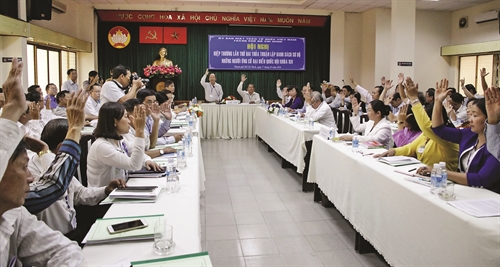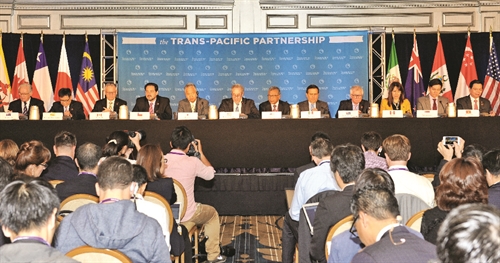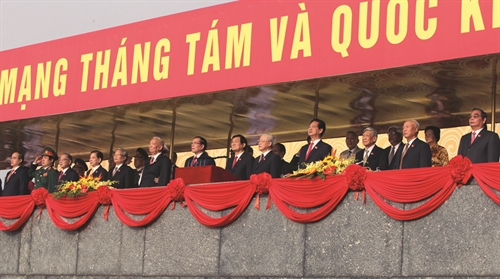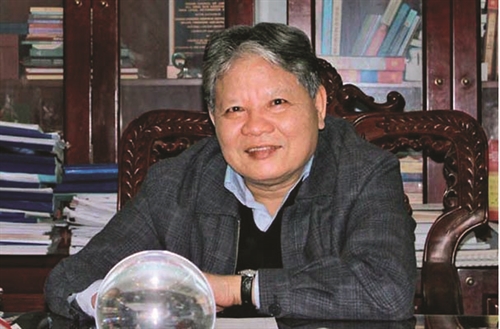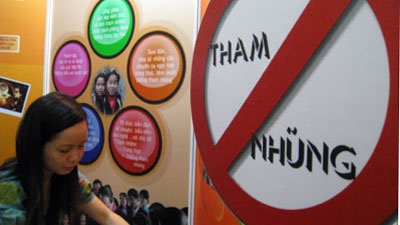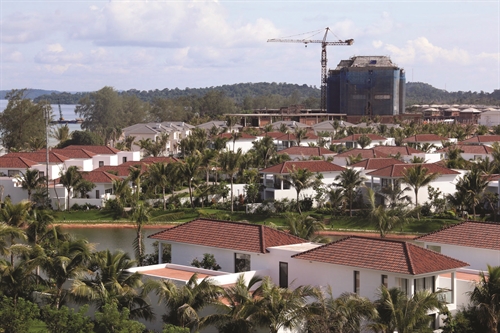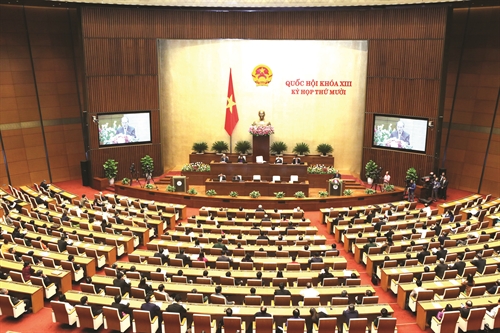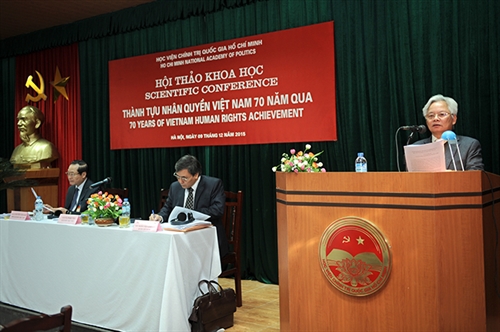Vu Nhu Thang, PhD
Director of the International Cooperation Department
Ministry of Finance
International economic integration plays a crucial role in accelerating economic development and enhancing the political position of Vietnam in the world. The finance sector’s integration and cooperation activities have actively contributed to promoting international economic integration and national economic reform through boosting international trade as well as regional and sectoral restructuring.
In 2015, along with further scrutinizing, revising and issuing tariffs for implementing the free trade agreements (FTAs) currently in force, the finance sector took the initiative in devising plans for negotiation and conclusion of several FTAs, including the Trans-Pacific Partnership (TPP) agreement, the European Union (EU)-Vietnam bilateral FTA, the Vietnam-Republic of Korea (RoK) FTA and the Vietnam-Eurasian Economic Union (EEU) FTA.
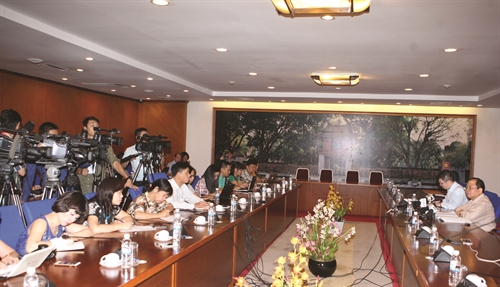 |
| A press conference on issues related to the state budget revenue-expenditure balance held in Hanoi__Photo: Pham Hau/VNA |
Fulfillment of trade liberalization commitments
Reduction of import duties
Regarding trade in goods, all of Vietnam’s FTA partners are big trading partners that make up over 80 percent of the country’s total annual trade volume. In 2015, China ranked top among Vietnam’s FTA partners, accounting for 20 percent of the country’s total two-way trade turnover, followed by the ASEAN, 12.8 percent; the US, 12.7 percent; the EU, 12.5 percent; the RoK, 11.3 percent; and Japan, 8.7 percent.
Last year, the Ministry of Finance (MOF) continued cutting import duty within the framework of eight FTAs currently in force, including the ASEAN Trade in Goods Agreement (ATIGA), ASEAN-China FTA, ASEAN-RoK FTA, ASEAN-Australia-New Zealand FTA, ASEAN-India FTA, ASEAN-Japan FTA, Vietnam-Japan Economic Partnership Agreement and Vietnam-Chile FTA. These duty cuts follow the roadmaps set in the Ministry’s circulars promulgating the Preferential Import Tariffs for the 2015-18 period. However, during the implementation, the ministry actively consulted and listened to opinions of related stakeholders so as to timely tailor tax policies to the needs of domestic enterprises while still adhering to the country’s commitments with FTA partners.
The MOF also devised tariff reduction roadmaps for implementation of commitments under the FTA with the RoK which came into force on December 25 last year, and the FTA with EEU.
Except for the ATIGA, which is an intra-regional agreement with liberalization commitments involving approximately 98 percent of tariff lines, almost all FTAs that Vietnam has signed require import duty cuts for around 90 percent of tariff lines. The ATIGA is also the pact that will complete its tariff liberalization roadmap first in 2018, followed by the ASEAN-China FTA in 2020 and the ASEAN-RoK FTA in 2021.
However, the tariff liberalization rates applied from 2015 under Vietnam’s commitments to its FTA partners are fairly high. For example, it is 93 percent under the ATIGA, 84 percent under the ASEAN-China FTA, 78 percent under the ASEAN-RoK FTA, and 62 percent under the ASEAN-Japan FTA. Right in 2015, the import duty rate of zero percent started to apply to many items with high import turnover from the ASEAN, China and the RoK such as iron and steel, fertilizers, electronic products, trucks, electric appliances, machinery and equipment.
As for the two new-generation FTAs - the TPP agreement and the EU-Vietnam FTA, Vietnam pledges higher liberalization rates which will be implemented according to shorter roadmaps, striving for the goal of eliminating all tariffs.
Under the EU-Vietnam FTA, immediately after the agreement comes into force 48.5 percent of tariff lines will become duty free, corresponding to 65 percent of Vietnam’s import turnover from the EU. After 10 years of implementation, the figure will mount to 99 percent, equivalent to 99.8 percent of the total import turnover from the EU, while remaining tariffs will be abolished afterwards.
As for the TPP agreement, Vietnam undertakes to abolish duties on around 66 percent of tariff lines right after the agreement enters into force and 86.5 percent of tariff lines three years later. Remaining items will be subject to tariff reduction roadmaps of between 4-10 years, while over-10-year roadmaps or tariff quotas will apply to a number of particularly sensitive items.
Hence, in the next three to five years, Vietnam will reach important milestones in the implementation of FTAs and gradually reach tariff liberalization for almost all of imports from the country’s big trading partners. The signing of two bilateral FTAs with the RoK and EEU and the conclusion of two important pacts - the TPP agreement and EU-Vietnam FTA, in 2015 provide a clear picture of Vietnam’s trade in the coming years with foreign exporters’ increasing accessibility to the domestic market.
Abolition of export duty
According to its commitments to the World Trade Organization (WTO) and signed FTAs, Vietnam is not obliged to cut export duty. The only exception is the two commodity groups of iron and steel and metal scraps for which import duty rates will be slashed to 17 percent and 22 percent respectively five years after the country joined the organization.
However, Vietnam’s partners within the new-generation FTAs, which are all developed countries, support the viewpoint on abolishing export duty as they consider export duty a form of subsidy for domestic production that distorts international trade. In light with this spirit, the Ministry of Finance has prepared plans on export duty commitments with the EU and TPP nations in line with the international trend while maintaining the country’s budget revenues.
Under the EU-Vietnam FTA, Vietnam pledges to abolish export duty for nearly all of its exports to the EU over a 15-year period with the remainder being subject to set ceiling export duty rates. Specifically, export duty will be removed for 546 items, including titanium and titanium ore according to a roadmap phased in 5-, 7-, 10-,12-, and 15-year periods, while export duty rates of 10-20 percent will apply to 57 commodity items, including minerals, metal ore, coal, gold and gold jewelry.
As for the TPP agreement, Vietnam reserves the export duty rates of 2-40 percent for around 70 export items, including coal, petroleum and some other minerals. The remainder will be free from export duty at the time the agreement enters into force or after 5, 7, 10 and 15 years.
Liberalization of financial services
Upon accession to the WTO, Vietnam committed a high level of liberalization for insurance and securities services. The country reserves just a few restrictions on opening of markets to foreign investors, not allowing the establishment of foreign insurers’ life insurance branches and cross-border provision of reinsurance cession services.
In fact, Vietnam’s accession to the WTO has helped create opportunities for the development of new products and lure professional investors to the country’s securities market. At present, Vietnam now has a total of 30 foreign-invested insurance companies. It is not to mention many foreign investors acting as strategic partners of local insurers. This has contributed to improving financial capacity and governance capability, diversifying and raising the quality of insurance products and services.
Under the signed FTAs, Vietnam does not commit to further open its insurance and securities markets. However, partners with developed service sectors like the EU and US often set strict requirements on market access as well as principles with a view to heightening responsibilities of member states to foreign investors. Given the still modest scope of Vietnam’s securities and insurance markets, negotiations on liberalization of the financial sector with the TPP partners and the EU have been carefully planned and conducted with appropriate and prudent steps.
Compared to existing FTAs, service commitments under the new-generation FTAs have several new characteristics.
Until now, when devising its schedules of commitments, Vietnam has always applied the positive list approach whereby only to-be-opened sectors will be listed in the schedules of commitments. The TPP agreement now requires commitments according to the negative list approach, i.e. sectors which are not stated in the schedules of commitments will be regarded as to be completely opened without any limitations. Such an approach may lead to difficulties as implementing regulations promulgated by member countries must not fall beyond non-conforming measures (NCM) such countries have reserved within the TPP.
Noteworthily, the TPP and EU-Vietnam agreements introduce two significant new mechanisms, namely the investor-state dispute settlement (ISDS) mechanism allowing foreign investors to initiate lawsuits against governments of host countries and the “ratchet mechanism” requiring that if a party adjusts certain existing restrictions, such adjustments will automatically become bound as part of such party’s market liberalization commitments.
The TPP agreement and EU-Vietnam FTA also contain some new commitments on market opening, requiring member states to permit the establishment of branches of foreign reinsurers; license the provision of new financial services by suppliers from other member states; offer the most-favored-nation treatment to providers of foreign securities services such as providing cross-border financial data processing, consultancy and supporting services; and open market for the service of cross-border investment portfolio management.
Financial integration in the new context
In 2016, international economic integration will continue to play an important role in boosting economic development and promoting Vietnam’s political position in the world. In the context where the deadlines for fulfillment of liberation commitments under a number of FTAs are approaching while the country is preparing for the implementation of its commitments under new-generation FTAs, Vietnam will further undergo a robust and comprehensive international economic integration process. In order to fulfill the 2016 financial-budgetary tasks assigned by the National Assembly and the Government, the finance sector’s integration and cooperation activities will focus on several tasks.
The MOF will concentrate first on the implementation of import tariff commitments under the concluded FTAs according to set roadmaps, closely supervising the implementation process while increasing consultations with the business community. The reason is that 2016 is a milestone in tariff liberalization under the concluded FTAs. Under the ATIGA, the zero percent rate will apply to 15 tariff lines of petrol and oil commodities, including diesel oil, while the import duty rate on automobiles will be further slashed to 40 percent. Meanwhile, the number of tariff lines with the import duty rate of zero percent will increase by 362 under the ASEAN-RoK FTA, by 2,453 under the ASEAN-Australia-New Zealand FTA, by six under the ASEAN-Japan Comprehensive Economic Partnership Agreement, and by 312 under the Vietnam-Japan Economic Partnership Agreement.
The second task is to work out a roadmap for fulfillment of customs tariff commitments and study commitments in the fields under the management of the finance sector under the TPP agreement and EU-Vietnam FTA so as to get ready once these agreements enter into force. Even though it takes time for these two pacts to come into force, as they are new-generation agreements with liberalization commitments covering a wide range of sectors, the MOF will have to work with other ministries, sectors and localities to review existing policies so as to propose amendments to suit Vietnam’s commitments.
The third task of the MOF relates to agreements for which negotiation is in progress or will be soon started such as the Regional Comprehensive Economic Partnership Agreement, Vietnam-Israel and Vietnam-Cuba FTAs. The MOF will prepare resources and consult other ministries, sectors, trade associations and local administrations so as to work out appropriate negotiation plans, ensuring the balance of benefits between Vietnam and partners.
As Vietnam has signed and is going to sign FTAs with almost all big trading partners around the world, tariff barriers on imports will be gradually eliminated. The MOF will focus its resources on further monitoring, studying and evaluating the impacts of tariff cuts under FTAs on budget revenue collection and domestic production, so as to timely propose adjustments to relevant policies. This is the MOF’s fourth task in this year.
The final task that the MOF will focus on in 2016 is to enhance policy dialogues and support domestic producers to take advantage of opportunities and cope with negative impacts brought about by the international economic integration process.
To fulfill the task, the MOF will increase policy dialogues with development partners and international organizations so as transparentize information and obtain donors’ confidence on development policies of the country. The ministry will also diversify forms of communication and proactively disseminate information on Vietnam’s commitments under FTAs, especially those on opportunities and benefits for Vietnam, conditions for Vietnamese goods to enjoy tariff incentives, and customs procedure reforms, among others.-
